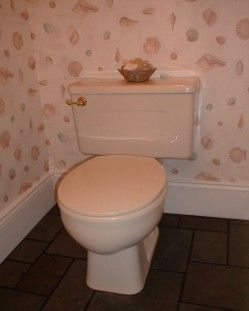DIY Bathroom Plumbing
DEAR TIM: I definitely have a leaking toilet. I have removed the ceiling beneath it and can see an occasional drip of water running down the actual main pipe beneath the toilet. When you go up to the bathroom, the toilet, floor and the walls are bone dry. Is the leak positively originating from the toilet? What could be the problem and the best way to repair it? Is it a realistic do-it-yourself project? Ed P., Essex Junction, VT
DEAR ED: Although I would not bet my life on the source of the leak, I am 99.999 percent sure the source of the leak is a failed seal between the toilet and the toilet flange. The toilet flange is a special drain pipe fitting that allows you to securely connect a toilet to the actual waste piping. The seal between the toilet and the flange could have failed for any number of reasons.

If you look at the underside of a toilet where the water and waste exit the fixture you will see that the china has a shape similar to a crude funnel. The shape of the toilet flange is also like a funnel only it is larger. When mated together properly, the actual china of the toilet fits loosely inside the actual flange. It is a classic male-female connection of sorts.
It is absolutely necessary for this joint to be sealed permanently. Not only does the seal prevent water leaks, but it also prevents harmful and objectionable sewer gas from escaping into your home. There are two ways to make the seal permanent: traditional wax gaskets or a newer seal device that incorporates high grade rubber o-ring seals with an adjustable sliding collar that attaches to the underside of the toilet.
Once you remove your toilet from the flange you will possibly discover that the toilet flange is not at the correct height. It can be either too high or too low with respect to the finish flooring. Being a licensed master plumber, I have learned over the years that the best seal occurs when the top of the toilet flange is one quarter inch higher than the finished flooring. It is also an enormous advantage to have the finish floor level in the area around the toilet. It goes without saying that the top of the toilet flange should also be level.
The toilet flange should also be securely attached to the sub-flooring material. Often this is not the case. Most modern flanges have multiple holes in the outer flange ring. The plumber who installs the flange is supposed to install screws through these holes into the sub-floor below. Do not confuse this task with the function of the actual toilet bolts. The bolts that are used to attach the toilet to the flange will indeed pull the toilet tight against the flange. But if the flange is not secure to the floor, the toilet can still move. Do not rely upon caulk or tile grout between the floor and the toilet to make a toilet like the rock of Gibraltar.
If you discover that the toilet flange is significantly lower than the finished floor surface, you can possibly add flange extenders on top of your existing flange. Not all plumbing inspectors will allow this retrofit. You must make sure that your local plumbing code allows these specialized fittings. These also must be properly sealed so that water and gas can not get between the old flange ring and the new one. If your local code does not permit the use of extenders, the actual piping and flange may have to be re-done. The same is true if the toilet flange is too high.
Working with toilets is not too terribly difficult but there are all sorts of challenges. If you think it is as easy as it is often shown on home improvement television shows, you are in for a surprise! When you disturb an existing toilet you can break the seals between the toilet tank and the toilet bowl. Reconnecting a toilet to the water supply line may also be an adventure. What's more, some plumbing codes and municipalities forbid unlicensed homeowners from working with plumbing drainage and water systems. If you decide to attempt the repair yourself, I sincerely hope you have a second functioning toilet in the home or you feel exceptionally lucky.
Column 428